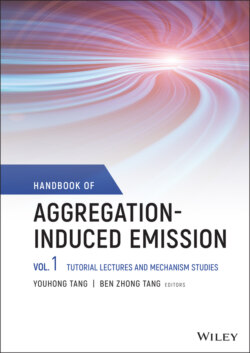Читать книгу Handbook of Aggregation-Induced Emission, Volume 1 - Группа авторов - Страница 25
1.6.2 Polymerization‐induced Emission
ОглавлениеRecently, Tang and coworkers have proposed polymerization‐induced emission (PIE), which is another conceptual innovation related to CTE [22]. It describes the process where the nonemissive monomers can be converted into luminescent polymers through polymerization. AIE process occurs mainly by physically manipulating the molecular motions, whereas PIE is achieved through the chemical ways accompanied by the CTE process. As versatile polymerization methods can be utilized to construct the PIE polymers, and these unusual luminescent polymers own good processability, the PIE acts as a promising solution in developing novel soft luminescence materials.
The working principle underneath is similar with CTE, nonconjugated subunits with rich electrons, such as phenyl, hydroxyl, and carbonyl groups, ether, and amide, can be connected into polymer chains by chain polymerization or step polymerization, and such polymer chains can be entangled and form multilevel structures through diverse intra‐ or interchain motions. Then, the electron‐rich moieties will aggregate into a cluster with electron overlapping in multiple microstructures and finally generate visible light. The emission intensity of the PIE polymers will increase with promoting the polymerization degree and the molecular weight. The intrinsic diverse structures endow the PIE polymers the potential to create diverse luminescence performance.
